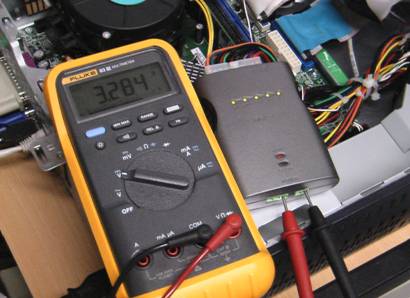This article was originally published in issue 45 of The Crypt Mag
Does your computer suffer from random crashes, freezes or otherwise strange behaviour and error messages? It is entirely possible that all of these problems could be the result of the power supply in your computer acting up.
Testing power supplies, especially in the majority of computers these days, can be quite a fiddly affair as they will remain in standby mode until they receive a signal from the motherboard to power up. This makes testing such a power supply for faults difficult as how can you power up the power supply to measure voltages without having it connected to the motherboard? One way would be to short the /PS_ON (power supply on, active low) pin to one of the ground pins on the main power supply connector causing it to power up. Another and much easier way is to use something like Antec’s ATX12V power supply tester.

I purchased this tester off of eBay for around £12 so it is a relatively inexpensive piece of kit. In the package you get the tester itself and a user manual which comes on a sheet of A4 paper in various languages.

The tester’s casing itself is quite stylish and I like the fact that it has hand grips which makes connecting and disconnecting quite comfortable.

There are individual LEDs for the +5V, +12V, +3.3V, -12V and 5VSB (5V standby) power rails and also LEDs marked GOOD and FAULT which give an indication of the power supply’s overall health. By following the LED indicators you can easily determine whether or not your computer’s power supply is faulty.


If a power rail is okay the relevant LED will show as green. If the voltage of a particular power rail is too low the LED will show as orange or if it is too high then it will show as red.
The tester will work with both 20-pin and 24-pin ATX power supply connectors. The top of the unit is marked where the edge of a 20-pin connector should go.


For those that want to measure the voltages from the power supply they can do so by using the test points as shown in the photo below. The group of three test points are for the +5V, +12V and +3.3V power rails and the group of two are for ground.

Interestingly in the photograph below the tester indicated that there was a fault on this particular power supply as the FAULT LED was lit. The power rail LEDs are all lit up as green indicating at least that these were all okay (although in the photograph they appear to be yellow).

In the photograph below a multimeter is connected to the +3.3V power rail using the tester’s test points measuring a rather acceptable 3.284V.

When trying out the tester on a second power supply it indicated that everything was fine with this one.

I could not find any information on what the tester classes as being too low or too high a voltage for the power rails. This is not a problem by any means and does not affect usage of the tester, but I personally like to know how tight the tolerances are in these things.
I would suggest that the tester is not left attached to a power supply for an extended period of time as I could start to feel the tester getting very warm to the touch after about five minutes use.
One thing that this tester will not do is test the power supply under load. If your power supply has problems providing sufficient power then this will not be picked up. To be fair this kind of testing is not what this tester is intended for and to test properly would require a much more complicated setup.
There are other power supply testers available which have additional connectors for testing the power leads for hard drives, floppy disk drives, etc. although I’ve never had a problem testing these types of connections since they are usually pretty accessible using a standard voltmeter. I guess it would really be down to personal preference whether or not you would want these features.
I think that Antec have produced a nice little tester for testing ATX power supplies and should be in the toolbox of anyone who builds or tinkers with computers.
PROS
- Inexpensive
- Simple to use
- Comfortable grip
- Test points for measurement using a voltmeter or multimeter
CONS
- Does not test power supply under load
- Does not have additional connectors to test power leads for hard drives, etc.
Article copyright © 2006, 2009 Francis G. Loch
